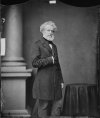Chapter 2: Mexican American War
Following the occupation of Mexico City by the United States forced under Major General Winfield Scott a New Mexican government was finally forced to the negotiating table. At first Mexican negotiators would only acknowledge the acceptance of Texas annexation by the United States, but not the Rio Grande as the border with Mexico. After months of of foot dragging President Polk sacked the diplomat Nicholas Trist. In his place instructed Mississippi politician turned soldier Major General John Quitman to take over the negotiations.
Quitman a firm believer in Manifest Destiny dreamed of annexing the whole country of Mexico into the United States. He made sure his counterparts from a Mexico knew of his ideals, and forced the diplomats into seclusion into an hacienda on the outskirts of the capital city. With threats of taking the whole country to placing Santa Anna back in control of the government Quitman was able to have a deal agreed upon by New Years Eve 1847. The United States would gain the following:
Alto California
Baja California
Nuevo Mexico
Sonora
Chihuahua
Nuevo Leon
Coahuila
Tamaulipas
Mexico received the following:
$25 million
$3 million in debt owed to United States citizens from Mexico
The treaty would be ratified by the US Senate 36 to 16 on March 10, 1848. With the fight on the battlefield the a United States now turned to another struggle. The political debate to decide the fate of the hard won territories. Both political parties the Democrats and the Whigs would put forth ideas, and the a Presidential Elections of 1848 now took center stage.
Following the occupation of Mexico City by the United States forced under Major General Winfield Scott a New Mexican government was finally forced to the negotiating table. At first Mexican negotiators would only acknowledge the acceptance of Texas annexation by the United States, but not the Rio Grande as the border with Mexico. After months of of foot dragging President Polk sacked the diplomat Nicholas Trist. In his place instructed Mississippi politician turned soldier Major General John Quitman to take over the negotiations.
Quitman a firm believer in Manifest Destiny dreamed of annexing the whole country of Mexico into the United States. He made sure his counterparts from a Mexico knew of his ideals, and forced the diplomats into seclusion into an hacienda on the outskirts of the capital city. With threats of taking the whole country to placing Santa Anna back in control of the government Quitman was able to have a deal agreed upon by New Years Eve 1847. The United States would gain the following:
Alto California
Baja California
Nuevo Mexico
Sonora
Chihuahua
Nuevo Leon
Coahuila
Tamaulipas
Mexico received the following:
$25 million
$3 million in debt owed to United States citizens from Mexico
The treaty would be ratified by the US Senate 36 to 16 on March 10, 1848. With the fight on the battlefield the a United States now turned to another struggle. The political debate to decide the fate of the hard won territories. Both political parties the Democrats and the Whigs would put forth ideas, and the a Presidential Elections of 1848 now took center stage.
Last edited:
